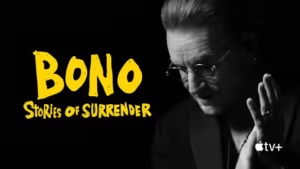
Out of My Mind (2024) – Complete Review – Zvideo
“Out of My Mind” (2024) is a compelling drama that explores the complexity of human behavior, the psychological impact of a traumatic past, and the consequences of an individual’s decisions. Directed by Amber Sealey and written by Daniel Stiepleman and Sharon M. Draper, the film features Phoebe-Rae Taylor as Dugdale, Luke Kirby, and Emily Mitchell in key supporting roles. Set against the backdrop of a heist gone wrong, the movie follows Dugdale’s tumultuous journey as she navigates through the wreckage of her choices.
The story begins with an explosive and dramatic moment—Dugdale, after being part of a high-stakes heist, finds herself standing amidst the opulent interiors of Russborough, soaking in the lavish surroundings. However, rather than bask in the success of her criminal achievement, Dugdale storms out in a fit of rage. Her unkempt wig and smudged eyeliner make her look like the Joker, and while her appearance may evoke images of chaos, Dugdale takes a different approach. Unlike the Joker, who thrives on creating havoc for its own sake, Dugdale is more methodical, calculated, and rational in her actions.
Though the movie opens with the dramatic aftermath of the heist, it doesn’t stop there. The film’s depiction of Dugdale’s life before her involvement in the crime, and the consequences that unfold, are presented with stark precision. The portrayal of Dugdale’s past, including significant events leading up to her involvement in terrorism, feels impersonal at times. Rather than delving deeply into the character’s motivations or exploring her emotional state in an intricate manner, the film instead relies on flashbacks and chronological events that are presented almost as if they were mere bullet points from a Wikipedia entry. This creates a certain detachment in the narrative, making it feel like a recounting of events rather than an in-depth exploration of Dugdale’s psyche.
Plot and Structure
The story of “Out of My Mind” is an intense rollercoaster, weaving a narrative that is as fascinating as it is unsettling. At the heart of the plot is Dugdale, a woman who seems both broken and driven. Her journey is marked by a series of chaotic and destructive decisions, as well as moments of introspection and self-realization. The film uses flashbacks to fill in the gaps of her life, gradually revealing the forces that shaped her present state of mind. However, while these flashbacks are effective in conveying key moments, they don’t always provide the emotional depth that could have truly elevated the film.
Dugdale’s life before her criminal activities is briefly summarized through these flashbacks, presenting her as someone who was shaped by a series of unfortunate events. However, the presentation of these events often lacks nuance. It’s as if the film assumes the audience will automatically understand Dugdale’s motivations based solely on the sequence of events, rather than exploring the emotional and psychological factors that drive her choices.
One of the more intriguing aspects of the film is the contrast between Dugdale’s public persona and her private life. While Dugdale is presented as an intelligent and determined woman in the public eye, her internal struggles are largely hidden. This duality is emphasized through the way the film juxtaposes her high-profile criminal activity with her quieter, more contemplative moments. However, the film doesn’t go far enough in exploring the dichotomy between these two sides of her character, leaving the audience with a sense of incompleteness.
The heist itself is presented as a pivotal moment in Dugdale’s life, but the way the film presents it feels somewhat detached. There’s a sense that the heist is merely a backdrop for Dugdale’s personal journey, rather than a central plot point that drives the action forward. As the film progresses, the audience is gradually introduced to key players in Dugdale’s life, each of whom plays a role in shaping her future. However, these characters often feel like mere plot devices rather than fully realized individuals, making it difficult for the audience to fully invest in their relationships with Dugdale.
Character Development
Phoebe-Rae Taylor’s portrayal of Dugdale is undoubtedly the film’s standout performance. Her ability to convey the inner turmoil of a woman caught between her past and her present is impressive. Taylor’s portrayal of Dugdale is both raw and controlled, capturing the complexity of a character who is constantly battling her own impulses. While the film doesn’t always give Dugdale the emotional depth she deserves, Taylor’s performance adds layers of complexity that make the character more compelling.
Dugdale is presented as someone who has experienced significant trauma in her life, yet remains determined to chart her own path. However, the film’s depiction of her character arc is inconsistent at times. While there are moments of vulnerability and self-reflection, these are often overshadowed by the film’s reliance on plot mechanics. Dugdale’s transformation throughout the film is interesting, but it doesn’t always feel earned. The movie introduces significant life events, but the emotional payoff often feels rushed or superficial.
In contrast, Luke Kirby and Emily Mitchell’s supporting characters are somewhat underdeveloped. While they serve important narrative functions, their motivations and backstories are often left unexplored. As a result, the film fails to create a strong emotional connection between the audience and these secondary characters. Despite this, Kirby and Mitchell do their best to bring life to their roles, contributing to the film’s overall atmosphere.
Cinematography and Visuals
Amber Sealey’s direction is complemented by strong cinematography that captures the emotional depth of the film. The lavish interiors of Russborough, where the film opens, are presented in sharp contrast to Dugdale’s internal chaos. The contrast between these two elements is visually striking, reinforcing the themes of the movie. The use of lighting and framing adds a layer of tension to the film, highlighting the characters’ emotional states and creating a sense of unease.
However, while the cinematography is effective in conveying the mood of the film, it sometimes feels overly stylized. The visual language of the film often emphasizes the dramatic moments, sometimes at the expense of the quieter, more intimate scenes. This creates a sense of dissonance in the narrative, as the film oscillates between moments of high drama and subtle introspection. While the style is visually striking, it occasionally detracts from the emotional core of the story.
Themes and Symbolism
“Out of My Mind” explores a range of themes, including the consequences of trauma, the search for self-identity, and the impact of past decisions. The film examines how individuals are shaped by their experiences and the choices they make, particularly when it comes to navigating difficult circumstances. Dugdale’s journey is one of self-discovery, as she grapples with the fallout from her actions and the consequences of her involvement in the heist.
The film also touches on themes of power and control, particularly in relation to Dugdale’s relationships with those around her. Her attempts to assert control over her life are contrasted with the chaotic forces that seem to constantly derail her efforts. This tension between control and chaos is a central theme throughout the film, and it serves to highlight the complexity of Dugdale’s character.
Additionally, the movie uses symbolism to explore Dugdale’s internal conflict. Her disheveled appearance, especially her unkempt wig and smudged makeup, serves as a visual representation of her emotional state. These elements emphasize the disarray in her life and the disconnect between her external persona and her internal struggles. While these symbols are effective in conveying Dugdale’s state of mind, they are sometimes overused, detracting from the subtlety of the narrative.
Conclusion
“Out of My Mind” (2024) is a film that offers a fascinating look into the life of a woman caught between her past mistakes and her present turmoil. While the film excels in terms of its visual style and Phoebe-Rae Taylor’s captivating performance, it falters in its emotional depth and character development. The reliance on flashbacks and the impersonal presentation of Dugdale’s life can make it difficult for the audience to fully connect with the protagonist. Nevertheless, the film’s exploration of complex themes and its portrayal of a woman struggling to regain control over her life make it a worthwhile watch for those interested in character-driven dramas. Despite its shortcomings, “Out of My Mind” offers a thought-provoking narrative that lingers long after the credits roll.







